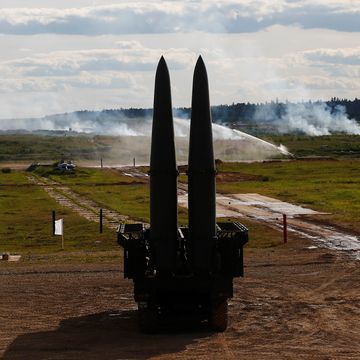A mysterious fighter with a new, large missile suspended underneath could be a Russian anti-satellite weapon. The MiG-31 “Foxhound” interceptor was spotted last month at an aircraft test site near Moscow carrying a missile that could be used as an anti-satellite weapon or a means of quickly placing small satellites in orbit.
According to Aviation Week & Space Technology, an experimental MiG-31 flew its first flight in September at the Zhukovsky aviation research center southeast of Moscow. Suspended under the MiG was a humongous missile previously unseen on the MiG-31 platform.
The MiG/missile combo is reportedly part of a restart of Russia’s anti-satellite weapon system. The original system, known as “Kontakt” (Contact), started in 1984 and involved a MiG-31D and the Fakel design bureau’s 79M6 missile. Later the MiG-31DM paired with the Fakel 95M6 missile. The 79M6 missile weighed 10,031 pounds and was launched by a MiG flying at Mach 2.55, traveling at 72,000 feet. The missile was guided by radar from the ground to its target, whereupon it detonated a small 4o-lb. warhead.
The Kontakt system was never tested against a satellite. Work on the system ended in 1991 with the dissolution of the Soviet Union, but there have been a number of calls to restart the program.
The United States Air Force tested a similar weapon, the ASM-135 ASAT (Anti-SATellite Weapon), in 1985. Launched from a modified F-15 Eagle, the ASAT was designed to destroy enemy satellites by colliding with them at speeds of nearly five miles per second. The U.S ran five ASAT test shots with one downing a NASA satellite. The program was shuttered after the satellite downing, and ASAT never became a fully operational weapon.
Another possible use for the new weapon would be a rapid reaction booster rocket capable of quickly launching small satellites into orbit. In 2001, MiG unveiled its concept for a modified MiG-31, known as MiG-31S (“S” for “space”, maybe). The MiG-31S would carry a large rocket, also designed by Fakel, capable of delivering a 220-lb. payload into low earth orbit or a 154-lb. payload to an altitude of 154 miles.
This new weapon system (if it is indeed real) would be useful to the Russian military in a wartime scenario. In any future conflict between great powers, military communications and navigation satellites will become prime targets, and Russia would need the ability to both shoot down enemy satellites and quickly replace its own losses. A system capable of handling both missions is the most economical option.

Kyle Mizokami is a writer on defense and security issues and has been at Popular Mechanics since 2015. If it involves explosions or projectiles, he's generally in favor of it. Kyle’s articles have appeared at The Daily Beast, U.S. Naval Institute News, The Diplomat, Foreign Policy, Combat Aircraft Monthly, VICE News, and others. He lives in San Francisco.













